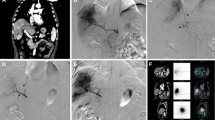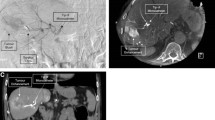Abstract
Purpose
In the presence of variant hepatic arterial anatomy, obtaining whole-liver coverage with yttrium 90 (Y90) radioembolization may be challenging. The purpose of this study was to determine whether a technique whereby variant hepatic arterial branches are embolized and then Y90 is administered selectively into one remaining hepatic arterial branch results in whole-liver coverage and effective therapy. A retrospective comparison of treatment response was made between a group of patients who underwent this technique before Y90 administration and a group of patients who received standard Y90 administration as a single dose into the proper hepatic artery or in divided doses into the immediate hepatic artery branches. The rest of the workup and treatment were identical in both groups, including routine embolization of potential nonhepatic, nontarget vessels (e.g., the gastroduodenal artery).
Methods
A total of 32 patients (mean age 56.9 years, range 39–77 years) treated with Y90 between June 2004 and March 2008 were analyzed. The primary malignancy was colorectal in 29, breast in 2, and cholangiocarcinoma in 1. Group 1 comprised 20 patients who had no alterations to their hepatic arterial supply. Group 2 comprised 12 cases who had undergone prior embolization of hepatic arterial branches before administration of Y90. The response to treatment was assessed by comparing standardized uptake value (SUV) on the pre- and postprocedure fludeoxyglucose positron emission tomographic studies of representative lesions within the right and left lobes of the liver.
Results
In group 1, significant response (P < 0.001) was seen among right lobe lesions but not among left lobe lesions (P = 0.549). In group 2, there was a significant response among both right (P = 0.028) and left (P = 0.014) lobe lesions. No difference was found in the response of right lobe lesions (P = 0.726) between groups 1 and 2; a significantly greater response was found in group 2 compared to group 1 (P = 0.004) for left lobe lesions.
Conclusion
Selective Y90 radioembolization after manipulation of hepatic arterial blood supply leads to an even distribution within the entire liver. When variations in hepatic arterial anatomy exist, this technique allows effective whole-liver radioembolization therapy from a single selective arterial injection.


Similar content being viewed by others
References
Ackerman NB, Lien WM, Kondi ES et al (1969) The blood supply of experimental liver metastases. I. The distribution of hepatic artery and portal vein blood to “small” and “large” tumors. Surgery 66:1067–1072
Kennedy A, Nag S, Salem R et al (2007) Recommendations for radioembolisation of hepatic malignancies using yttrium-90 microsphere brachytherapy: a consensus panel report from the radioembolization brachytherapy oncology consortium. Int J Radiat Oncol Biol Phys 68:13–23
Atassi B, Bangash AK, Bahrani A et al (2008) Multimodality imaging following 90Y radioembolizsation: a comprehensive review and pictorial essay. Radiographics 28:81–99
Young JY, Rhee TK, Atassi B et al (2007) Radiation dose limits and liver toxicities resulting from multiple yttrium-90 radioembolization treatments for hepatocellular carcinoma. J Vasc Interv Radiol 18:1375–1382
Donato P, Coelho P, Rodrigues H et al (2007) Normal vascular and biliary hepatic anatomy: 3D demonstration by multidetector CT. Surg Radiol Anat 29:575–582
Tohma T, Cho A, Okazumi S et al (2005) Communicating arcade between the right and left hepatic arteries: evaluation with CT and angiography during temporary balloon occlusion of the right or left hepatic artery. Radiology 237:361–365
Gunji H, Cho A, Tohma T et al (2006) The blood supply of the hilar bile duct and its relationship to the communicating arcade located between the right and left hepatic arteries. Am J Surg 192:276–280
Chuang VP, Wallace S (1980) Hepatic arterial redistribution for intra-arterial infusion of hepatic neoplasms. Radiology 135:295–299
Arai Y, Takeuchi Y, Inaba Y et al (2007) Percutaneous catheter placement for hepatic arterial infusion chemotherapy. Tech Vasc Interv Radiol 10:30–37
Cianni R, Urigo C, Notarianni E et al (2009) Selective internal radiation therapy with SIR-spheres for the treatment of unresectable colorectal hepatic metastases. Cardiovasc Intervent Radiol 32:1179–1186
Szyszko T, Al-Nahhas A, Canelo R et al (2007) Assessment of response to treatment of unresectable liver tumours with 90Y microspheres: value of FDG PET versus computed tomography. Nucl Med Commun 28:15–20
Sebastian AJ, Szyszko T, Al-Nahhas A et al (2008) Evaluation of hepatic angiography procedures and bremsstrahlung imaging in selective internal radiation therapy: a two-year single-center experience. Cardiovasc Intervent Radiol 31:643–649
Lewandowski RJ, Sato KT, Atassi B et al (2007) Radioembolization with 90Y microspheres: angiographic and technical considerations. Cardiovasc Intervent Radiol 30:571–592
Bilbao JI, Garrastachu P, Herráiz MJ et al (2010) Safety and efficacy assessment of flow redistribution by occlusion of intrahepatic vessels prior to radioembolization in the treatment of liver tumors. Cardiovasc Intervent Radiol 33:523–531
Kennedy AS, Kleinstreuer C, Basciano CA et al (2010) Computer modelling of yttrium-90-microsphere transport in the hepatic arterial tree to improve clinical outcomes. Int J Radiat Oncol Biol Phys 76:631–637
Werner MK, Brechtel K, Beyer T et al (2010) PET/CT for the assessment and quantification of (90)Y biodistribution after selective internal radiotherapy (SIRT) of liver metastases. Eur J Nucl Med Mol Imaging 37:407–408
Cosin O, Bilbao JI, Alvarez S et al (2007) Right gastric artery embolization prior to treatment with yttrium-90 microspheres. Cardiovasc Intervent Radiol 30:98–103
Satou S, Sugawara Y, Tamura S et al (2007) Three-dimensional computed tomography for planning donor hepatectomy. Transplant Proc 39:145–149
Conflict of interest
Drs. N. P. Tait and H. S. Wasan have acted as medical advisors for Sirtex Medical Products Pty. Ltd., North Ryde, Australia. Dr. N. Karunanithy received financial support from Sirtex Medical to attend the Global Embolisation Symposium and Technologies 2010 Meeting. F. Gordon has no conflict of interest.
Author information
Authors and Affiliations
Corresponding author
Rights and permissions
About this article
Cite this article
Karunanithy, N., Gordon, F., Hodolic, M. et al. Embolization of Hepatic Arterial Branches to Simplify Hepatic Blood Flow Before Yttrium 90 Radioembolization: A Useful Technique in the Presence of Challenging Anatomy. Cardiovasc Intervent Radiol 34, 287–294 (2011). https://doi.org/10.1007/s00270-010-9951-6
Received:
Accepted:
Published:
Issue Date:
DOI: https://doi.org/10.1007/s00270-010-9951-6




